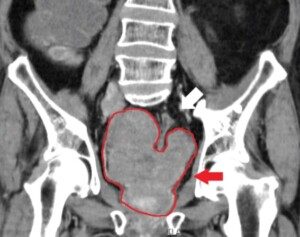Despite the fact that some slim or straight-size people acquire serious medical conditions, obesity remains a major modifiable risk factor for death worldwide from top causes.
This topic is being covered because, very unfortunately, there’s just no end in sight to all the content creators out there pitching that obesity isn’t a leading risk factor for and cause of many serious forms of illness.
Some of these creators are medical professionals, which is really scary.
Ironically, some of these health professionals, who preach on Instagram and TikTok that you can be in perfect health and still be fat, aren’t even overweight themselves.
Obesity As a Risk Factor
Obesity is defined by the World Health Organization (WHO) as having a body mass index (BMI) of 30 or higher.
It’s also defined as being at least 20% over one’s ideal weight.
All sorts of physical and medical problems are far more likely when a person is morbidly obese: at least 100 pounds over.
Difficulty with mere walking can be easily observed in someone, even younger adults, who’s 200 pounds overweight.
- Their heart is beating for two bodies.
- How can this be irrelevant to that person’s health?
Still believe bodies can be just fine despite morbid obesity?
Critics of the fat acceptance movement often point out that the heart was not designed to beat for two bodies, and this alone can cause significant problems to a very overweight person’s health.
But many in the fat liberation camp deny this obvious fact.
But if having a massively sized body doesn’t strain the heart, then why is heart strain the reason that a baby, born with two heads but just one heart, dies shortly after birth?
There are adult conjoined twins who seemingly — by appearance — are one body with two heads, but internally they are not a single body, and they have two sets of lungs and also have two separate hearts.
But a single heart in conjoined twins who have a single body but two heads is unable to provide adequate circulation for two separate brain structures.
The brain requires a substantial amount of oxygenated blood to function properly, and the combined demand from two brains would overwhelm the capacity of a single heart, particularly if the heart has to support multiple organs in addition to two brains.
According to a study published in The Lancet (Sullivan et al., 2003), conjoined twins who share a heart may experience severe circulatory problems because the heart’s capacity to pump blood efficiently becomes compromised – leading to heart failure.
So what does a two-headed baby with a single heart have to do with morbid obesity?
A lot. If a heart fails due to the excess strain of pumping for two brains, imagine the strain on a heart that’s pumping for the equivalent of two, let alone three, whole bodies.
That’s a LOT more extra weight than a second head.
Plus, in obesity the heart is overworked also because morbid heaviness leads to increased volume of blood vessels – because as fat cells get bigger, they need new blood vessels to support this growing tissue. That’s a lot of excess work for the heart.
Vascular endothelial growth factor, a key protein that promotes blood vessel growth, is elevated in obese individuals, stimulating development of new blood vessels (Hall et al., Diabetes, 2000).
All this blood vessel growth raises the heart’s workload – even while the individual sleeps.
In addition, obesity-induced hypoxia (low oxygen levels) in expanding fat cells triggers the activation of hypoxia-inducible factors.
This promotes even more blood vessel creation, to restore oxygen supply (Liu et al., Endocrinology, 2015).
While this increased vascularity supports the metabolic needs of the expanding fat tissue, it also contributes to inflammation and metabolic dysfunction, which are common in obesity.
This information should be enough to convince people, who deny obesity’s dangers, that an abundance of excess fat is just so very harmful.
Just So Very Harmful
The Framingham Heart Study, one of the longest running studies of cardiovascular risk, found that those with higher BMI numbers were more likely to develop heart disease, stroke and type 2 diabetes (Wilson et al., Circulation, 1998).
Specifically, for every 5-point increase in BMI, the risk of coronary artery disease jumped significantly.
A study published in The Lancet Diabetes & Endocrinology (Uhlmann et al., 2014) found that obese people had a much higher incidence of insulin resistance, which leads to type 2 diabetes.
Plus, fatness is associated with chronic inflammation, a factor that accelerates the development of insulin resistance (Hotamisligil, Nature, 2006).
This is not an isolated finding; numerous studies confirm that excess body fat, particularly visceral fat (fat that surrounds organs), is forceful in the development of metabolic diseases.
Stop Pointing Out that Thin People Get Sick Too
While slender people are certainly not immune to illness, research indicates that a lean body mass does not carry the same health risk burden as does obesity.
A slender body is typically associated with lower levels of visceral fat, which has been shown to be more harmful than fat beneath the skin (subcutaneous) in terms of metabolic and cardiovascular health (Smith et al., Obesity Reviews, 2009).
Maybe you’ve heard of the term “skinny fat.” These are people with a slender or straight-size body, but with levels of fat in a range that can heighten cardiovascular risk.
And yes, they have that higher risk. But this doesn’t invalidate the titanic amounts of research showing that obesity, particularly morbid, is a goliath of a risk factor for so many disease processes.
In non-overweight, slim and skinny people, conditions such as stroke, chronic heart failure, sleep apnea and cancer are driven by other factors.
These include (no particular order) smoking, uncontrolled high blood pressure, a junk food diet, genetics and workplace exposures.
However, smoking, drinking or a sedentary lifestyle do not negate the overwhelming evidence that weighing 350 pounds, even 250, is a leading contributor to disease.
A Very Big Heavy Body Causes Poor Mobility and Stamina
It’s been said that “If you waddle, you’re not healthy.”
As we age, particularly after 40, excess weight more and more affects mobility and stamina.
You don’t need the research to know this. You only need a decent pair of eyes.
Obesity affects even the movement and stamina of young kids – as evidenced by the overt lack of fat young bodies at jungle gyms, climbing gyms, roller rinks, playgrounds and in sports where a lot of running is done.
A study in The American Journal of Public Health (Pahor et al., 2006) found that overweight and obese adults were more likely to report difficulties in activities of daily living.
Examples are using stairs, housework, cleaning the interior of a car, even just prolonged walking at a mall.
Our skeleton and joints were not designed to support the weight of two people.
Content Creators Must Stop Spreading Medical Misinformation
Yes, people with slender, thin or “normal-weight” bodies can experience serious illnesses.
But research overwhelmingly supports the conclusion that obesity is a major risk factor for many leading causes of death, disability and chronic pain.
Being fat also has a significant impact on mobility and stamina, especially as people get older.
Don’t let that 20-something, 250 pound influencer fool you with her 10-second clip of dancing and high kicking.
Gravity and the aging process will wreak havoc on a fat body.
 Lorra Garrick is a former personal trainer certified by the American Council on Exercise. At Bally Total Fitness, where she was also a group fitness instructor, she trained clients of all ages and abilities for fat loss and maintaining it, muscle and strength building, fitness, and improved cardiovascular and overall health.
Lorra Garrick is a former personal trainer certified by the American Council on Exercise. At Bally Total Fitness, where she was also a group fitness instructor, she trained clients of all ages and abilities for fat loss and maintaining it, muscle and strength building, fitness, and improved cardiovascular and overall health.
.










































